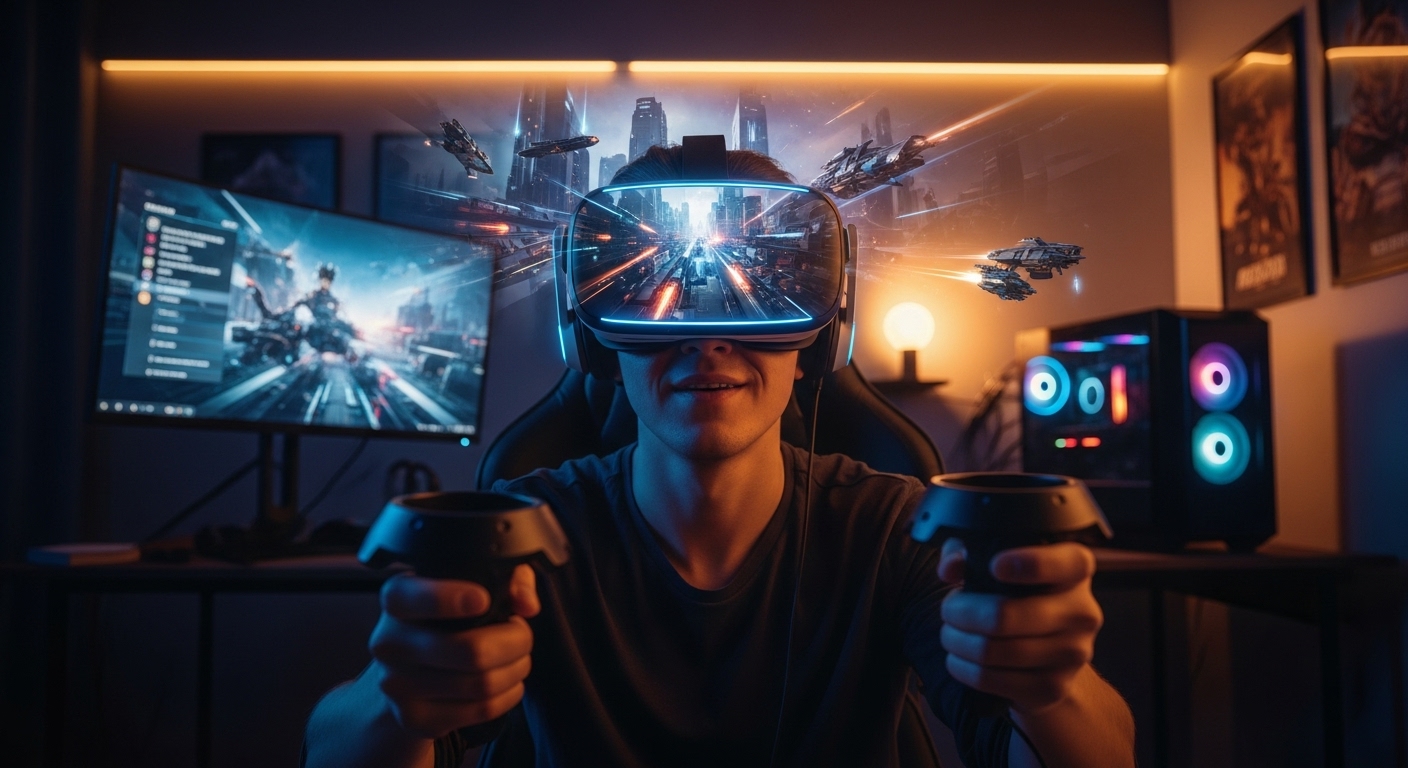
The Impact of Virtual Reality on Modern Gaming: A Deep Dive
Virtual Reality (VR) has become a transformative force within the gaming industry, offering immersive experiences that have fundamentally changed how players interact with digital worlds. This technology, which once seemed a futuristic dream, has now become a crucial component of modern gaming. In this blog post, we will explore the profound impact VR has had on the gaming landscape, delve into the technological advancements driving this change, and examine the future prospects of VR in gaming.
The Evolution of Virtual Reality in Gaming
The journey of VR in gaming can be traced back to the late 1980s when early prototypes of VR headsets were developed. However, it wasn’t until the 2010s that technological advancements made VR a viable commercial reality. The introduction of devices like the Oculus Rift and HTC Vive marked a turning point, providing gamers with unprecedented levels of immersion.
These headsets offered high-definition displays, low-latency tracking, and intuitive controls, allowing players to step into virtual worlds with a sense of presence that traditional gaming platforms couldn’t match. The development of VR gaming was further accelerated by the use of advanced graphics engines and motion tracking technologies.
Immersive Experiences Redefining Gaming
One of the most significant impacts of VR on gaming is the level of immersion it provides. Traditional gaming relies heavily on visual and auditory stimuli, but VR adds an entire dimension of interaction. Players are no longer passive observers; they become active participants in the game world.

Consider games like Half-Life: Alyx, which utilizes VR’s capabilities to create a fully interactive environment. Players can physically reach out to manipulate objects, aim weapons with precision, and explore richly detailed environments that react to their presence. This level of immersion makes the gaming experience more engaging and emotionally impactful.
Social and Collaborative Aspects
VR gaming is also reshaping the social dynamics of gaming. Multiplayer VR games create a sense of presence among players that traditional multiplayer setups cannot replicate. Platforms like VRChat and Rec Room allow users to create avatars, interact in a virtual space, and participate in various activities together.
This social aspect of VR gaming fosters a unique sense of community and collaboration. Players can join forces to tackle challenges, compete against each other, or simply socialize in virtual environments. The ability to communicate and interact in a shared virtual space enhances the overall gaming experience, making it more inclusive and engaging.
Technological Innovations Driving VR Gaming
The rapid advancements in technology have been crucial to the success of VR gaming. High-resolution displays, improved field of view, and advanced motion tracking systems have all contributed to enhancing the VR experience. Furthermore, the development of wireless VR headsets has eliminated the constraints of cables, offering players greater freedom of movement.

Another significant innovation is the integration of haptic feedback devices that allow players to feel physical sensations corresponding to in-game actions. These devices, such as VR gloves and vests, add an extra layer of realism, making interactions within virtual environments more tangible and believable.
Challenges and Limitations
Despite its many advantages, VR gaming still faces several challenges. The high cost of VR equipment remains a barrier for many potential users. Additionally, issues like motion sickness and the physical discomfort of wearing a headset for extended periods limit VR’s accessibility.
Development for VR platforms also presents unique challenges. Game developers must consider the physical space players need to move around, design intuitive controls, and ensure that virtual environments are optimized for VR hardware. These considerations can complicate the game development process and increase production costs.
The Future of VR in Gaming
The future of VR in gaming looks promising, with continuous advancements aimed at addressing current limitations. Companies are investing in research to develop more affordable and comfortable VR equipment. Innovations in AI and machine learning are also expected to enhance the intelligence of virtual environments, providing more dynamic and responsive game worlds.
Moreover, the integration of Augmented Reality (AR) with VR could open up new possibilities, creating hybrid experiences that blend the virtual and physical worlds. This convergence could lead to new genres of games and applications, further expanding the potential of VR technology.

As technology continues to evolve, we can anticipate even more sophisticated and immersive VR experiences. The gaming industry, driven by consumer demand for innovation and immersion, will undoubtedly continue to explore the potential of VR, pushing the boundaries of what is possible in digital entertainment.
Takeaways
The impact of virtual reality on modern gaming is undeniable. By offering unparalleled levels of immersion and interaction, VR has transformed the gaming experience, making it more engaging, social, and realistic. While challenges remain, the continued advancement of VR technology promises to overcome these hurdles, making VR an integral part of the future of gaming.
As we look ahead, it is clear that VR will play a pivotal role in shaping the gaming landscape. The ongoing development and integration of VR technology into mainstream gaming will not only enhance the way we play games but also redefine the boundaries of digital interaction and entertainment.
VR Beyond Gaming: Broader Implications
While our exploration has primarily focused on VR’s impact within the gaming industry, it is important to acknowledge the broader implications of VR technology. The immersive capabilities of VR are being harnessed in various fields, including education, healthcare, and training, demonstrating the versatility and potential of this technology beyond entertainment.
In education, VR can create interactive and engaging learning environments. Students can explore historical sites, conduct virtual experiments, or visualize complex scientific concepts in ways that traditional methods cannot achieve. This immersive learning experience can enhance comprehension and retention, making education more effective and accessible.

Healthcare is another sector where VR is making significant strides. For example, VR simulations are being used for surgical training, allowing medical professionals to practice procedures in a risk-free environment. Additionally, VR is employed in therapy to treat conditions such as PTSD and phobias by exposing patients to controlled virtual scenarios.
The training and simulation industry also benefits from VR technology. Industries like aviation, military, and manufacturing use VR simulators to train personnel in realistic yet safe environments. This approach reduces costs and risks associated with traditional training methods while increasing the effectiveness of skill acquisition.
Consumer Adoption and Market Growth
The adoption of VR technology is on the rise as more consumers recognize its potential and the industry continues to address barriers to entry. According to reports, the global VR market is poised for significant growth, with projections indicating a multi-billion-dollar industry in the coming years.
This growth is driven by several factors, including decreasing hardware costs, improvements in VR content quality, and increased awareness and acceptance of VR technology. As VR becomes more mainstream, we can expect a broader range of applications and experiences tailored to diverse consumer preferences.
Community and Developer Ecosystem
The thriving community and developer ecosystem surrounding VR technology play a crucial role in its advancement. Developers and enthusiasts continuously contribute to the growth and innovation of VR by creating new content, tools, and platforms that enhance the overall VR experience.

Platforms like SteamVR and the Oculus Store provide developers with the resources and support needed to bring their VR projects to life. This, in turn, enriches the VR landscape with a diverse array of games and applications, catering to different interests and expanding the reach of VR technology.
Ethical Considerations and Future Challenges
As VR technology permeates more aspects of our lives, it raises important ethical considerations that must be addressed. Issues such as user privacy, data security, and the potential for addiction are critical areas that require attention from developers, policymakers, and users alike.
Ensuring that VR experiences are inclusive and accessible to individuals with disabilities is another challenge that the industry must confront. By prioritizing inclusivity, VR technology can offer transformative experiences to a broader audience, fostering a more inclusive digital world.
Conclusion: Embracing the VR Revolution
The impact of virtual reality on modern gaming and beyond is a testament to the transformative power of technology. As VR continues to evolve, it will redefine how we interact with digital content, offering immersive experiences that transcend traditional boundaries. By embracing this VR revolution, developers, consumers, and industries alike can unlock new possibilities and shape the future of digital interaction.
In conclusion, the immersive, social, and educational potential of VR technology positions it as a pivotal force in the evolution of not just gaming, but numerous other sectors. As we advance, the challenge and opportunity lie in harnessing this technology responsibly and creatively to create a more connected, immersive, and engaging digital future.







